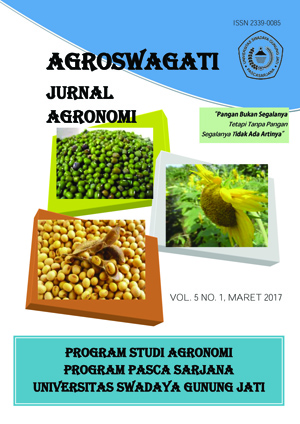EVALUASI KESUBURAN BEBERAPA JENIS TANAH DI LOKASI PERKEBUNAN TEBU PABRIK GULA PT. TERSANA BARU KABUPATEN CIREBON
DOI:
https://doi.org/10.33603/agroswagati.v5i1.1890Kata Kunci:
Soil Fertility, Sugar Cane Plantation, and The area in Tersana Baru Cirebon PGAbstrak
"The decline in sugar cane production and sugar cane fields in the last ten years has been volatile. That is, not every year in that period has decreased, "Muhidin said. Sugar cane farmers do tend to shift from sugar cane cultivation to other types of crops which are considered more profitable. Another opinion on the transition of cultivation is due to the low sugar cane randeman. The reduced rendering resulted in many farmers switching from sugar cane to more profitable crops of rice, corn, shallots and secondary crops.
The causes of the lower rendering value include conditions of high rainfall and lack of nutrients in the soil. This lack of nutrients is because the soil has been used too long for sugarcane cultivation, this causes a reduction in soil fertility. Basically, soil testing or soil analysis has two functions: 1) showing nutrient status in the soil (management history, potential and management) and 2) can serve as a basis for monitoring production systems and measuring trends or changes in fertilization programs. By knowing the availability of nutrients, it can do the right fertilization and can increase soil fertility, so that the rendeman yield increases. Therefore, a Land Analysis Study in the Sugarcane Plantation Area was conducted.
The purpose of this research study is to identify the amount of nutrients to provide accurate information about the conditions of soil fertility in sugarcane plantation areas in Cirebon. The objectives of this research study are: 1) to determine the fertility value of sugarcane plantation areas in Cirebon and 2) to find out the factors that cause reduced nutrient content in the soil. In general, the method used in this study is by using laboratory analysis methods and qualitative descriptive methods. The results of the study are 1) in general the soil fertility status (SKT) for the 10 regions taken from soil samples is low both from the top soil and sub soil soil layers; 2) the nutrient content of Nitrogen in the soil for these 10 regions is low so it is necessary to fertilize the appropriate ZA and NPK to improve the soil fertility status of each location; 3) fertilizer recommendations made for the 10 regions are by adding Nitrogen, lime (dolomite) and manure as basic fertilizer at the beginning of planting; and 4) factors that cause reduced nutrient content are declining soil fertility status due to excessive inorganic fertilization, pesticide use, and the absence of crop rotation.Referensi
Badan Pusat Statistik Kabupaten Cirebon. 2015. Kabupaten Cirebon Dalam Angka. Badan Pusat Statistik Kabupaten Cirebon, Cirebon.
Chandra Indrawanto, dkk. 2010. Budaya dan Pasca Panen Tebu. ESKA Media. Jakarta
Distanbunakhut. 2016. Laporan Produksi Perkebunan Tebu Lima Tahun. Dinas Pertanian Perkebunan Peternakan dan Kehutanan Kabupaten Cirebon, Cirebon
Distanbunakhut. 2016. Laporan Sasaran Area Perkebunan Tebu Lima Tahun. Dinas Pertanian Perkebunan Peternakan dan Kehutanan Kabupaten Cirebon, Cirebon
Ditjenbun, 2004. Pedoman Teknologi Budidaya Tebu Lahan Kering. Jakarta
Hakim, M. 2008. Tebu, Menuju Swasembada Gula Dengan 4 Pilar Trobosan. Emha Training Center & Advisory, Bandung
Mulyana, W. 2001. Teori dan Praktek Cocok Tanam Tebu Dengan Segala Masalahnya. Aneka Ilmu, Semarang.
PTPN VII. 1997. Vademecum Tanaman Tebu. Bandar Lampung
Sugeng Winarso. 2005. Kesuburan Tanah Dasar Kesehatan dan Kualitas Tanah. Gava Media. Yogyakarta
Supriyadi, A. 1992. Rendemen Tebu: Liku-liku Permasalahannya. Kanisius, Yogyakart
Unduhan
Diterbitkan
Terbitan
Bagian
Citation Check
Lisensi
The Authors submitting a manuscript do so on the understanding that if accepted for publication, copyright of the article shall be assigned to Jurnal AGROSWAGATI, Sekolah Pascasarjana Ilmu Pertanian. Universitas Swadaya Gunung Jati as publisher of the journal. Copyright encompasses rights to reproduce and deliver the article in all form and media, including reprints, photographs, microfilms, and any other similar reproductions, as well as translations.
Jurnal AGROSWAGATI, Universitas Swadaya Gunung Jati and the Editors make every effort to ensure that no wrong or misleading data, opinions or statements be published in the journal. In any way, the contents of the articles and advertisements published in Jurnal AGROSWAGATIare the sole responsibility of their respective authors and advertisers.











